|
26th August 2018:
Stevenston, Saltcoats and Irvine Harbour
What a pain! After a week of nice weather, widespread rain was predicted for
Sunday. It was to fizzle out gradually from the west by late afternoon. My mind
therefore turned to how I could rise to the challenge of taking interesting
pictures of birds in the rain. We decided West was best and chose to visit our
favourite section of the North Ayrshire coast, Stevenston, Saltcoats and Irvine
Harbour.
Stevenston:
After our usual brekkies in Stevenston Morrisons (9/10, -1 for asymmetrical
toast), we drove onto Stevenston Point and waited for a lull in the continuous
driving rain. That didn’t happen, but we found that if we sheltered by the side
of the car, sitting on our 3-legged stools, then by covering my camera with a
plastic bag, I could take shots of birds active in the area. And active they
were! Cormorants were on the rocks at the tip of the Point, Gannets were
passing regularly and were even treating us to some dramatic diving and Shags
were coming and going unconcerned by the rain. John spotted a pair of Razorbills
diving just offshore. I also managed to catch a Common Guillemot to the left of the
shot
A wee Pied Wagtail looked very vulnerable as it sat on the jagged rocks.
Overhead, a Curlew flew effortlessly south against the very stiff breeze (see
“Pictures of the Week”, below). A few croaking Sandwich Terns patrolled the
waters, seeking out small fish. After an hour of dodging the wind and rain we
felt we’d seen all we were going to see and headed for Saltcoats. As we passed
by an area of short grass, I noticed a Great Black-backed Gull and its juvenile
feeding there. The adult didn’t seem too interested in feeding the young bird
which eventually got the message and started to forage for itself. A Common
Gull glided across the grass at camera height and provided a nice
photo-opportunity (see “Pictures of the Week”, below).
| Pied Wagtail |
Sandwich Tern |
Great Black-backed Gull |
Great Black-backed Gull 1st Cycle |
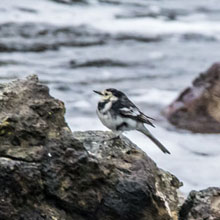 |
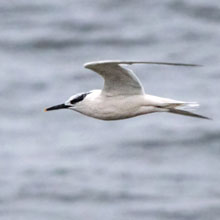 |
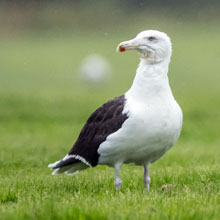 |
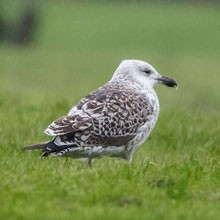 |
We parked at Saltcoats Harbour and were greeted by a Herring Gull hovering
above us. Out in the Harbour entrance a few Gannets were making multiple dives
into the choppy waters. The rain wasn’t letting up but as we were sheltered by
the high Harbour wall, I simple stood and waited for the birds to pass. A
female Eider and its juvenile paddled past, but we were disappointed by the
otherwise empty seas and sky. We cut our losses and made for Irvine Harbour
hoping we’d have more luck there. As we returned to the car, I snapped a few
shots of a Herring Gull making short work of a rain-saturated slice of bread.
| Herring Gull |
Gannet |
Female Mallard |
Herring Gull |
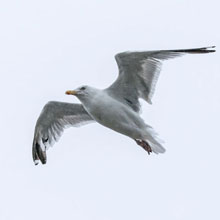 |
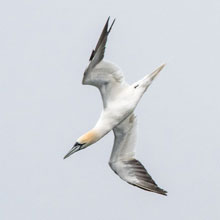 |
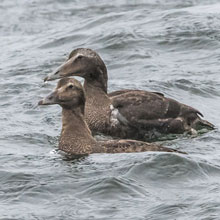 |
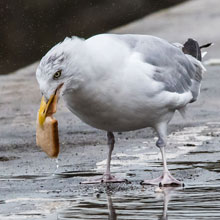 |
Irvine Harbour
We got out the car at Irvine and much to our surprise and delight, the rain
had stopped! A drookit Carrion Crow was picking its way through the grass and
in the estuary a few Eider were making their way under the footbridge that
leads across to the disused “Big Idea” science museum.
In the middle of the largely vacant car park, a pair of juvenile Herring
Gull were harassing their parent for food, which was not forthcoming. Their
instinct is to tap the red spot on their parent’s bill which, in turn, is
supposed to stimulate the parent to regurgitate some food. That did not happen,
but like human children, that didn’t stop them carrying on with their pleas.
(see “Pictures of the Week”, below). As we neared the toilet block (now taken
over as a base for Coastwatch), a couple more members of the Corvid family were in evidence. A
bedraggled-looking Jackdaw was sifting its way through the grass and ....
| Carrion Crow |
Female Mallard |
Herring Gull |
Jackdaw |
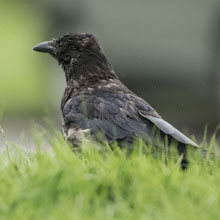 |
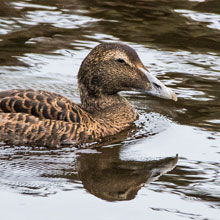 |
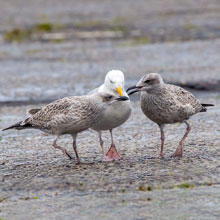 |
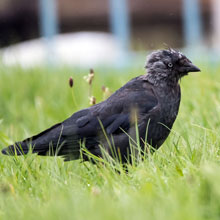 |
..... a pair of Rooks surveyed the area from the relative safety of the
Toilet Block roof. Nearby, on the side of the, now renovated Pilot’s House,
a pair of Feral Pigeons were caught canoodling. We made our way out along the
walkway separating the beach from the Estuary. Several Pied Wagtails were
scurrying about on the sloping edges. A few Herring Gulls were there too,
ever-watchful for the discarded chip or biscuit from pedestrians.
| Rook |
Feral Pigeon |
Pied Wagtail |
Herring Gull |
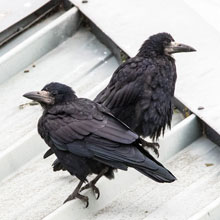 |
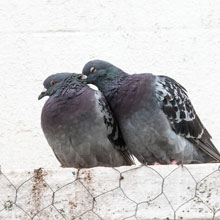 |
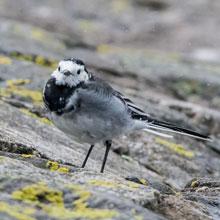 |
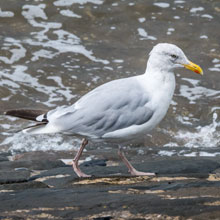 |
From the walkway we observed a Cormorant as it flew North onto the Ardeer
Peninsula. Over the Pavilion I spotted a Sparrowhawk circling and then it too
went onto the Peninsula, pursued by some Crows. On the other side of the
Estuary mouth, yet another Cormorant was sitting drying its wings atop a post.
There has been some debate as to why Cormorants spread their wings, however the consensus seems to point to obvious reason, they’re drying their
wings! As we made our way back to the car, a pair of Mute Swans glided past.
Our species count had certainly climbed since arriving At Irvine Harbour.
| Cormorant |
Sparrowhawk |
Cormorant |
Mute Swan |
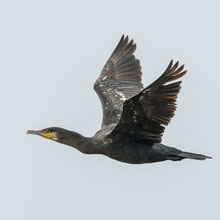 |
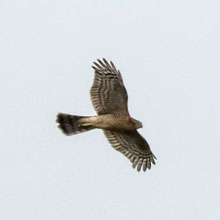 |
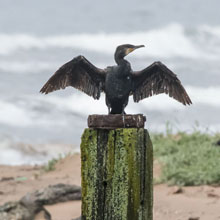 |
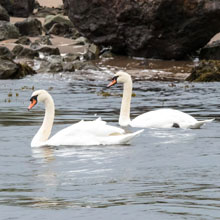 |
And so it continued. A Black-headed Gull made appearance. We hadn’t seen as
many of them on our recent trips, probably as they were reproducing. An
immature shag flew upstream and under the footbridge, followed seconds later by
a lone Oystercatcher. Opposite where we had parked, a Great Black-backed Gull
stood proudly on a wooden post (see “Pictures of the Week”, below). Our final
capture was spotted by John. It was a juvenile female Goosander diving for fish
fish at the confluence of the Rivers Irvine and Garnock. Easy to confuse with a
female or juvenile Red-breasted Merganser, its white chin and thicker bill
point me towards Goosander. Its plumage is not full and seems to be that of a
juvenile.
| Black-headed Gull |
Shag |
Oystercatcher |
Juvenile Female Goosander |
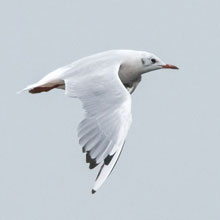 |
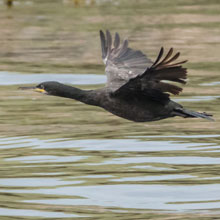 |
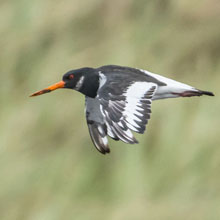 |
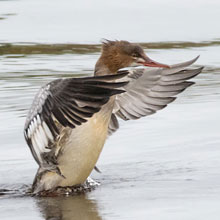 |
Well I think we managed to find a fairly interesting set of pictures for
this blog, so the weather didn’t defeat us. Of course we celebrated with a
repeat of last week’s treat, cream muffins loaded with lemon curd, washed down
with strong tea (Had the weather defeated us we would have consoled ourselves
in exactly the same way!). Surely the weather will be better next week?
Pictures of the Week:
| Curlew |
Common Gull |
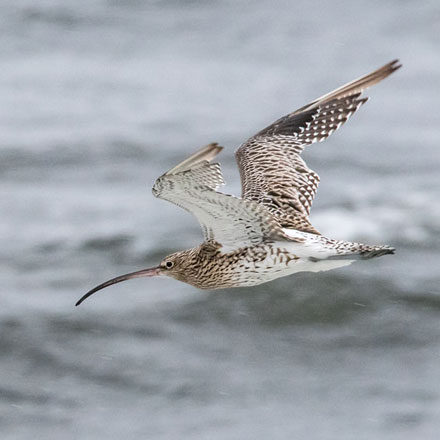 |
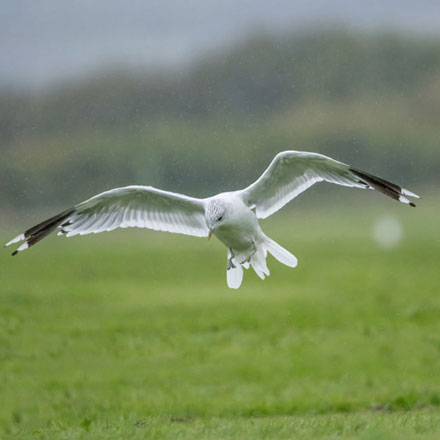 |
| Herring Gull 1st Cycle |
Great Black-backed Gull |
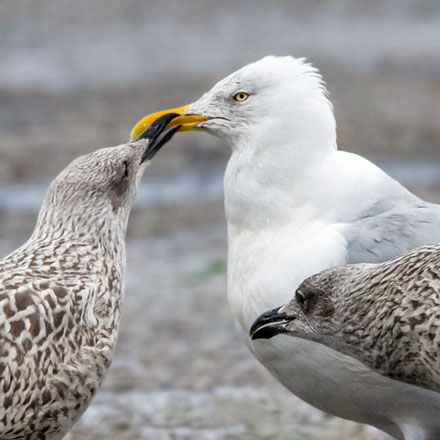 |
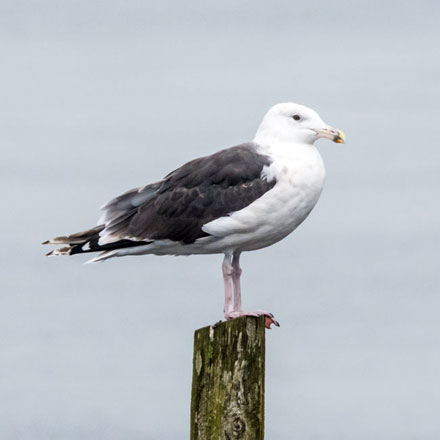 |
19th August 2018: Turnberry and Maidens
The Saturday
evening weather prediction for Sunday was very similar to that
for the previous week: rain clearing from the south-west, getting
brighter by
late afternoon. So once again (after a lovely breakfast in Stewarton
Morrisons
East Kilbride (9/10)) we found ourselves belting down the M77, this
time
heading for Turnberry Lighthouse. Twitter has reported a previous
day’s
sighting of a Basking Shark there as well as a long list of fairly
common
birds. As luck would have it, the Sun was shining when we arrived, and
our walk
from the new car park, across the world-famous Trump Turnberry golf
course to
the Lighthouse was very pleasant . We stopped to photograph beautiful,
raindrop-covered Harebells. By the path on Yarrow I noticed the
aptly-named
Thick-thighed Hoverfly, syritta pipiens. Its swollen rear upper legs
made it
look as if it had eaten some Popeye’s spinach. Beside it was
a neat-looking
female Hoverfly.
We settled just
above the rocks that were recently exposed be the receding
tide, and scanned the horizon and waited for the birds, or sharks, or
dolphins,
to come to us. First to pass was an Oystercatcher with its familiar
piping
call. There were fairly frequent close passes of Gannets that were
probably
based on Ailsa Craig. The sky was now mainly cloud with only a few
dashes of
blue. A lone Curlew was next to catch the eye as it sped north, and to
complete
the set of familiar feathery friends a few Cormorants flew across the
rocks.
| Oystercatcher |
Gannet |
Curlew |
Cormorant |
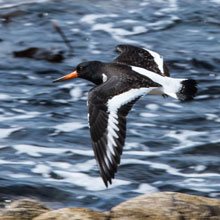 |
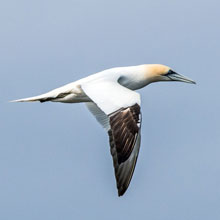 |
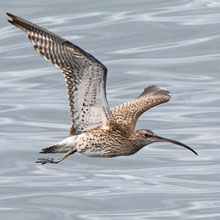 |
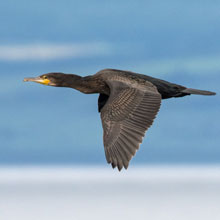 |
In the far
distance, against the light, a flock of mainly Ringed Plovers
zig-zagged a path onto rocks a few hundred metres away. It was then
that John
thought he may have spotted the Basking Shark, but ultimately decided
it was
just a rock. He took a couple of shots of it anyway. However when
looking at
our pictures later that evening, I edited the pair of shots so that
their
backgrounds were identical and I compared the position of the
“rock” in the
photos. As you will see below, in “Pictures of the
Week”, it changes position
from one picture to the other, leaving me to conclude that it may very
well have
been the Basking Shark! Certainly the fin has shape of a Basking
Shark’s dorsal
fin and it was in that area the previous day (and the day after). So
“Well
spotted John!”.
We decided to
relocate to Maidens. On our way around the Lighthouse I
snapped a couple of shots of a hairy, black and orange-striped
caterpillar I
noticed on the grass. It was a Fox Moth caterpillar. On our way back to
the car
park we came across some wildflowers now getting to the end of their
blooming
season. A few areas of Bramble bushes were in fruit.
| Golden Plover |
Basking Shark |
Fox Moth Caterpillar |
Bramble |
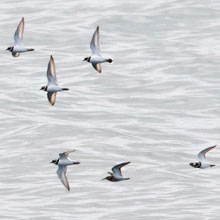 |
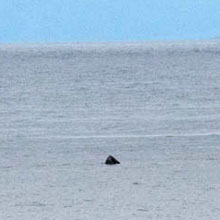 |
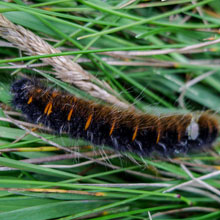 |
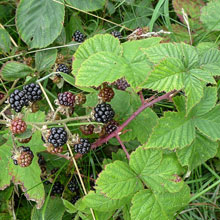 |
By the
roadside, in long grass, I snapped a rather worn-looking Yellow
Fieldcap mushroom. I noticed very pretty flowers of Field Bindweed in
the same
patch of grass. Their pink and white blooms were about 3 or 4cm across.
Further
down the road it’s “big cousin”, Large
Bindweed was in flower. Its all-white
blooms were up to about 7cm across. I also photographed a beautiful
example of
Red Campion, one of my favourite flowers (see “Pictures of
the Week” below”).
As we got into the car I noticed that the car park was line with large
examples
of Fat Hen, a plant that is cultivated as a grain or vegetable crop in
Asia and
Africa, but other parts of the world, especially Europe and North
America, it
is treated as a weed.
| Yellow Fieldcap |
Field Bindweed |
Large Bindweed |
Fat Hen |
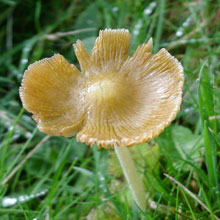 |
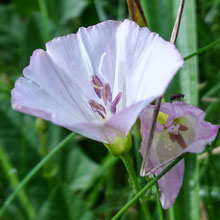 |
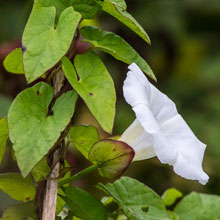 |
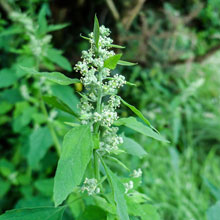 |
We drove the
mile and a half up the road to the bonny coastal village of
Maidens. It was now rather overcast, and the dog walkers were out and
had
already flushed the birds from the beaches and harbour. Oystercatchers
were put
up, followed by Dunlin and Redshank. A more tolerant Rock Pipit seemed
to
accompany us as we picked our way along the rocks to the shore.
| Oystercatcher |
Rock Pipit |
Dunlin |
Redshank |
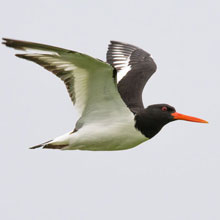 |
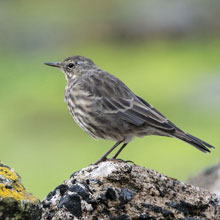 |
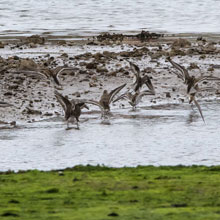 |
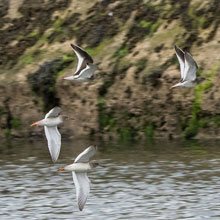 |
We paused at a
Ragwort plant which was laden with insects. Prominent amongst
these was a largish (~5cm), tired-looking moth, uresiphita gilvata. It
was
brown with worn markings but had distinctive orange hind wings with
black
border, which aided identification. Beside it, on the other end of the
scale
(~1.5cm) was a Pale Straw Pearl moth, udea lutealis. It’s
pale markings were
rather faint, but adequate for identification. Third in the trio of
moths was a
Rosy Rustic moth, hydraecia micacea. This disappointingly un-rosy moth
was
about 3cm long and had a hair back. It is disliked by farmers as its
caterpillar bores into their crops’ lower stems and roots. As
we approached the
beach, John was impressed by the Wild Rose bushes heavily loaded with
bright
red hips. Perhaps he remembers his mum giving him rose hip syrup.
Apparently
Wild Rose hips contain twenty times as much vitamin C that oranges do.
| Moth - Uresiphita Gilvata |
Moth - Pale Straw Pearl |
Moth - Rosy Rustic |
Wild Rose |
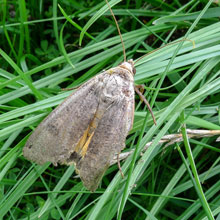 |
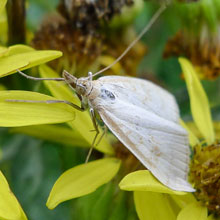 |
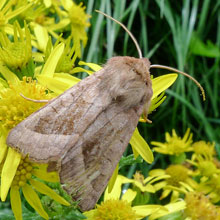 |
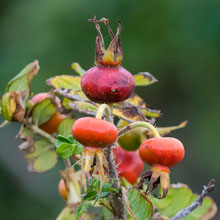 |
We surprised a
young Herring Gull that had been merrily devouring a crab on
the rocky edges of the Harbour. It carried it over onto the sea wall in
order
to complete its meal in peace. A stately Great Black-backed Gull posed
atop the
large rocks, with a grey Isle of Arran in the background. Another large
bird, a
Grey Heron, stood motionless on neighbouring rocks, before moving
south, no
doubt searching for its next meal. More dogs in the area displaced a
young
Cormorant availing us of the opportunity of a flight shot as it passed
us. Dog
walkers can be useful sometimes.
| Herring Gull 1st Cycle |
Great Black-backed Gull |
Grey Heron |
Cormorant |
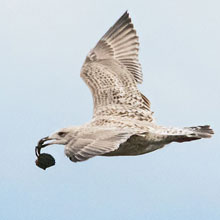 |
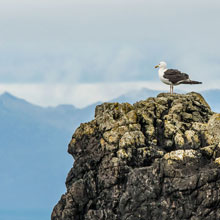 |
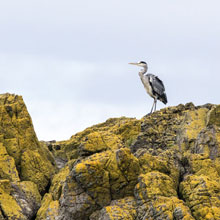 |
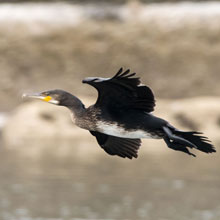 |
So eventually
it turned out to be “mission accomplished”, albeit
without a
super-dooper picture of the Basking Shark. From the shore we were only
ever
going to see a couple of fins anyway. I’m pleased with my
detective work of
comparing successive photos to establish it was moving. The reward for
our good
work was tea and cream muffins loaded with lemon curd. They were
scrumptious!
The weather/light was ok at times but let’s hope it improves
further next week.
Pictures Of The Week
| Basking Shark |
Red Campion |
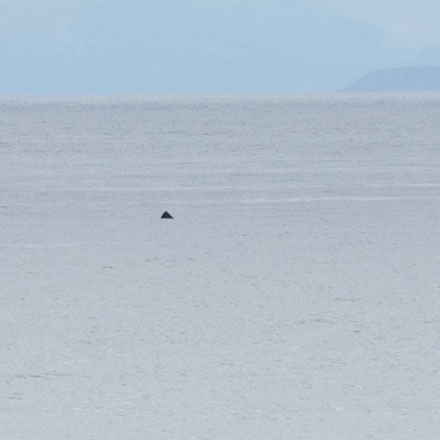
|
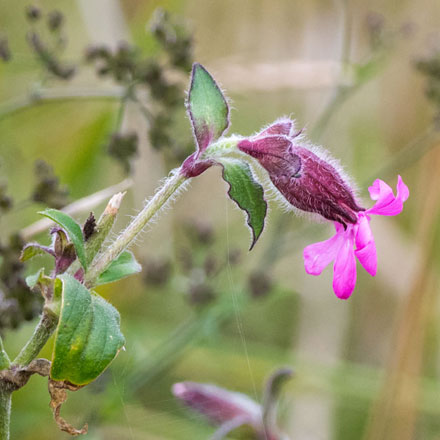 |
| Mute Swan |
Cormorant |
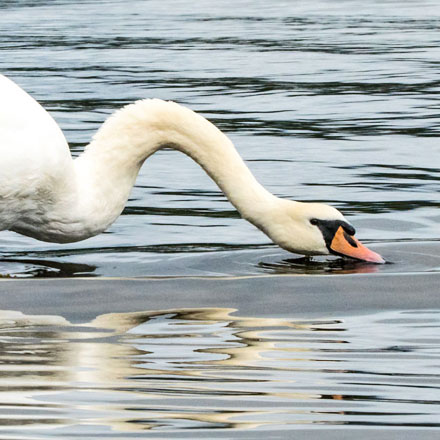 |
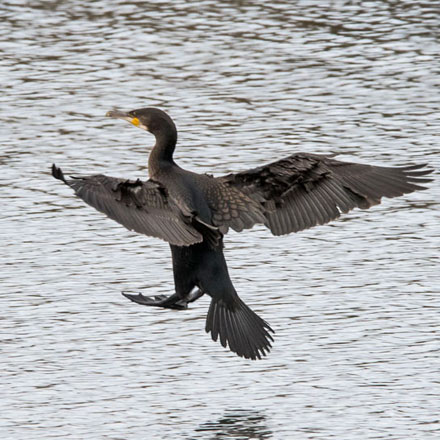 |
Troon
12th August 2018
The weather
forecast was very poor
- the whole of Central Scotland was to be cloaked in a gloomy sheet of
slow-moving rain. But in the south-west the rain was to clear by late
afternoon, which offered us a glimpse of opportunity for some nature
photography. We headed down the M77 towards Ayr, making our customary
pit stop in Kilmarnock ASDA for breakfast (7/10 - duff toast and cold
cafe), but as we approached the turn-off for Prestwick, the rain had
stopped and we decided to settle for nearby Troon.
We parked in
the South Beach car
park and walked towards Meikle Crags and in the far distance we could
see Ayr. First up, a pair of Jackdaws pecking at something or other on
the seaweed-strewn foreshore. I spotted some small waders ahead of us.
For once, a dog walker helped us out as his best friend put up the
birds, who then flew past us. I shot multiple exposures from which I
could see they were mainly Dunlin with a few Ringed Plovers. I could no
longer see Ayr as it had been shrouded in rain advancing from the
south. We turned tail and made for the car. On the way I snapped a
Carrion Crow as it foraging on the stinking seaweed.
Jackdaw
|
Dunlin
|
Ringed Plover
|
Carrion Crow
|
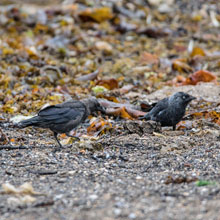
|
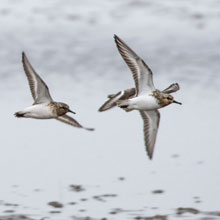
|
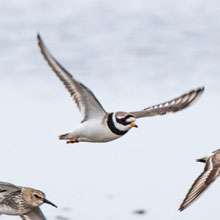
|
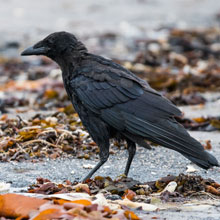
|
We relocated to
the Harbour car
park, by which time the rain arrived. As we waited for it to pass, a
reproduction Viking boat sailed past. I Googled “Viking
longboat Troon”
but ended up none-the-wiser as to what it was doing there. From the
picture it seems well kitted out with engine, radar, aerial and cabins
so it may not be local, and could have been just making its way around
the coast. From inside the car I photographed the Vikings as well as a
drookit Cormorant that seemed right at home in the rain. On the grass,
by the car, a very damp Starling was raking through litter for any
tit-bits it could find. Meantime, a small, twin-hulled boat had
appeared offshore. It had what looked like four divers onboard. After
watching it for some time John thought they were laying marker buoys,
for what, I don’t know.
Three
adult
Herring Gulls parked themselves on the grass beside a car whose
occupants were devouring fish suppers. The gulls were very vocal, but
unsuccessful in the efforts, as the greedy humans ate the lot. The rain
stopped about an hour before we were due to leave so we got out the car
and walked north towards the Harbour wall. Oystercatchers on the rocks
had their beaks under wings as they rested at high tide. A few small
waders scurried ahead of us. They were Ringed
Plover and Turnstones, but they fled before I could
capture their images. On the wall there were a few Shags, but little
else.
Herring Gull
|
Oystercatchers
|
Ringed Plover
|
Shag
|
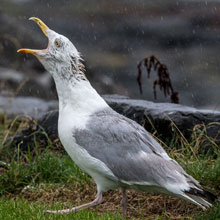
|
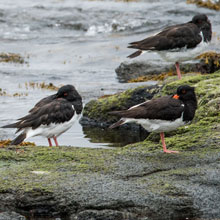
|
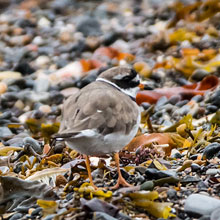
|
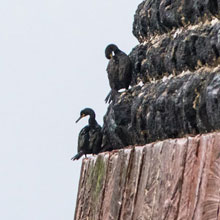
|
On and around
the pebbly beach
below the sea wall there were several species of wildflower still in
bloom. Prettiest of these was a patch of Pencilled Cranesbill, a type
of Geranium. Possibly a garden escapee, it’s flowers were
attractively
covered in pearls of water. Next I noticed the yellow crucifer, Sea
Radish. It had only a few flowers as most had gone, leaving swelled,
seed-rich ovaries. Clinging to the wall, a Silverweed plant, sometimes
mistaken for a buttercup, still had its distinctive yellow flower.
There were a few patches of Common Ragwort growing at the base of the
wall. The beauty of the nice, wee yellow flowers belie the fact that
all parts of the plant are poisonous to mammals, including us, if eaten.
Pencilled Cranesbill
|
Sea Radish
|
Silverweed
|
Common Ragwort
|
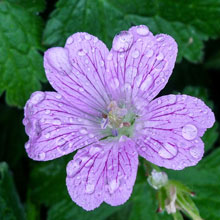
|
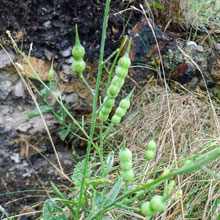
|
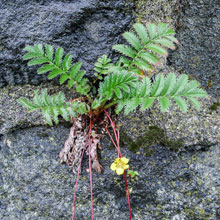
|
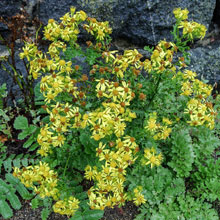
|
Another wildflower in the
running for the prettiest bloom was the Large
Bindweed. Even in the low light it was beautiful. Less attractive, Sea
Rocket was
another plant showing seed capsules. Each capsule contains a pair of
smooth,
brown seeds. Our exploration of the seashore flora was interrupted by
the
croaking of a Sandwich Tern that was diving for fish. The light had
improved
well enough for us to be able to see the lighthouse on Lady Isle.
The small
island has quite a bit of history.
We decided to
have a scan of the
area to the south end of the car park. Before long, John uttered,
“There’s Sammy at one o’clock!”
(our code for “I see a Seal just to the
right of straight ahead!”). In fact, it was a Grey Seal
taking a bit of
a breather between dives. We sat on our wee 3-legged stools on a
slipway, giving us a grand view over the rocks. Some divers had just
been fishing offshore and were cooking them in the area just behind us.
So with the smell of BBQ in my nostrils I photographed in quick
succession two ever-present favourites, a Pied Wagtail and a Rock
Pipit. Our final capture was a nice one, a female Wheatear. I remember
seeing one in the same place in August last year. Maybe it was the same
bird.
Grey Seal
|
Pied Wagtail
|
Rock Pipit
|
Female
Wheatear
|
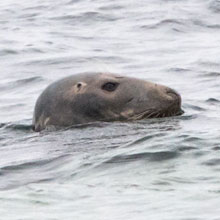
|
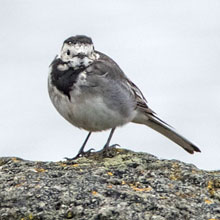
|
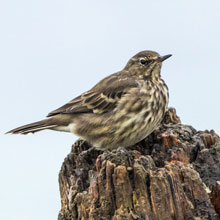
|
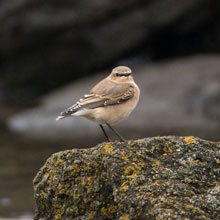
|
So,
after a promising start, the middle of the visit was a bit of a damp
squib, but once the rain stopped we got a lot of sightings in a short
time. We celebrated that “grand recovery” with tea
and caramel-iced
eclairs. Hoping to see the sun next week.
Pictures of the
Week:
Herring Gull
|
Ringed
Plover
|
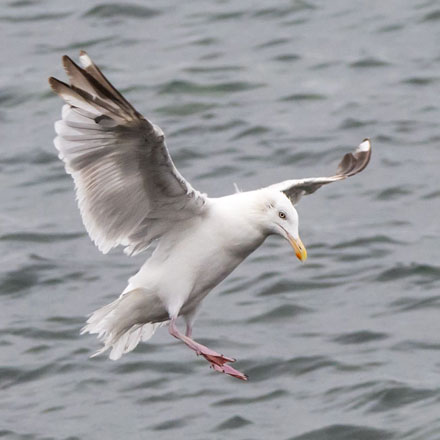
|
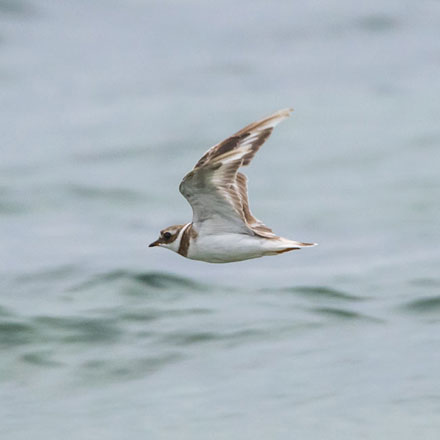
|
Rock Pipit
|
Female Wheatear
|
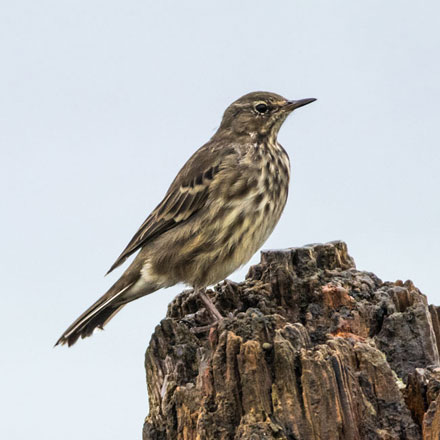
|
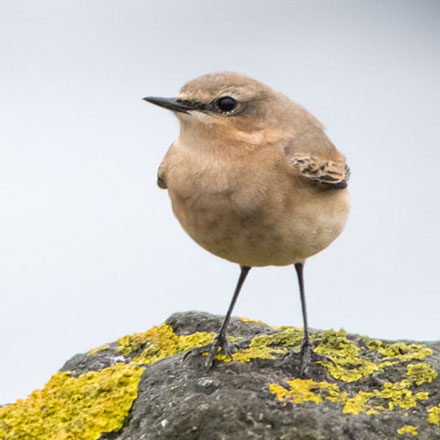
|
5th August 2018:
Musselburgh
This weekend we
returned to one of
our favourite sites for the first time in about 15 weeks - Musselburgh.
Reports of bird sightings on social media were encouraging, as were
weather predictions, so by mid-morning on Sunday we found ourselves
tucking into breakfasts in Dalkeith Morrisons prior to what we hoped
would be a productive few hours around the mouth of the Esk and Scrapes.
We parked at
the Levenhall Links
and made our way across the 100m footpath across wild grassland. We saw
lots of butterflies there including the Small White and the more
flighty Meadow Brown (which managed to evade the camera). We also
snapped a White-tailed Bumblebee on a Perennial Sow Thistle. At the sea
wall John pointed out a pair of immature Herring Gulls fighting over a
Starfish. We moved westwards accompanied by the familiar call and sight
of Oystercatchers as group after group sped from their resting places
in the Scrapes towards the feeding grounds at the mouth of the Esk.
Small White Butterfly
|
White Tailed Bumblebee
|
Herring Gull
|
Oystercatcher
|
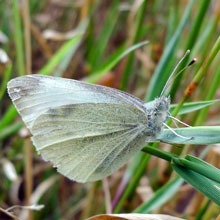
|
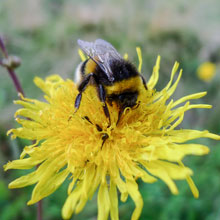
|
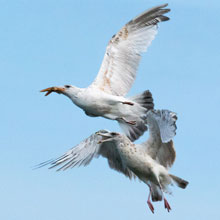
|
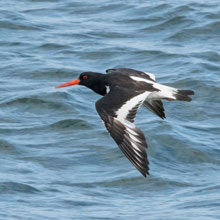
|
The familiar
“rusty door hinge”
call of the Sandwich Tern was next to draw our attentions. They too
were streaming seawards out of the Scrapes in fair numbers. We noticed
that a few of them were juveniles and we theorised that parent birds
were tutoring their latest offspring in the skills of fishing. This was
supported by our observation that many were returning back to the
Scrapes with silvery fish in their bills. On our way into the Scrapes I
took a few pictures of 7-spot Ladybirds nesting in the grassy verges of
the path. Just outside one of the hides a few Speckled Wood butterflies
were very active, males searching for females and frequently tussling
with other like-minded males.
Sandwich
|
Tern
|
7 Spot Ladybird
|
Speckled
Wood
Butterfly
|
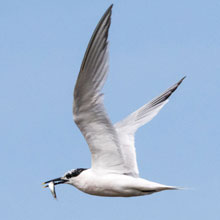
|
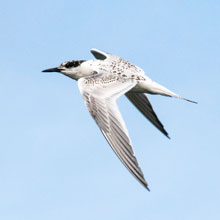
|
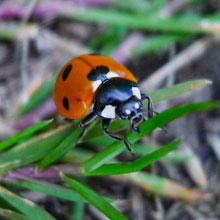
|
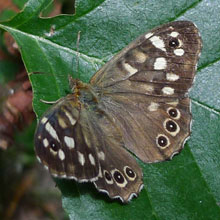
|
As expected,
since the tide was
now low, the Scrapes were a bit short of birds. A single Lapwing sat
opposite the middle hide and a pair of Shelduck were feeding in the
middle of the centre scrape. A distant Common Sandpiper foraged far to
the right, but, apart from some distant Mallards and a Curlew that was
it. I noticed a large patch of Hare’s-foot Clover immediately
in front
of the hide and manage a fairly good picture using my big zoom lens.
Lapwing
|
Shelduck
|
Common Sandpiper
|
Hare's-foot Clover
|
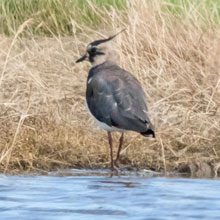
|
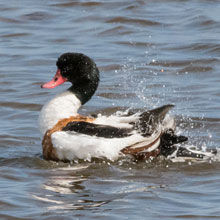
|
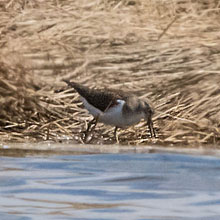
|
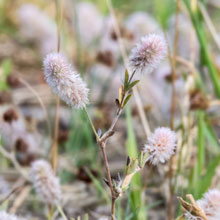
|
As we left the
Scrapes, John
directed me towards a Meadow Brown butterfly, which, for once, sat
still long enough for a quick shot. On the footpath that lead us back
to the seawall we came across three rather nervous juvenile Pied
Wagtails scouring the path for invertebrates. The flew off as we
apprached. At the seawall we had a close encounter with a strangely
approachable pigeon. Each of its legs were ringed, which could indicate
that it was a Racing Pigeon having a bit of a pit-stop. As we sat
observing the pigeon, a Kestrel sped past and proceeded to hunt the
grassy banks that run parallel to the “promenade”.
Meadow
Brown Butterfly
|
Juvenile
Pied Wagtail
|
Racing Pigeon
|
Kestrel
|
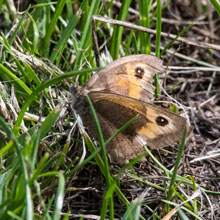
|
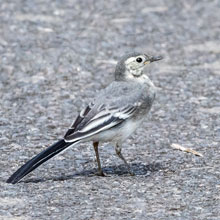
|
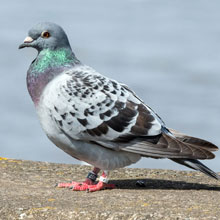
|
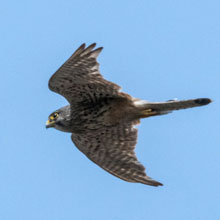
|
As we continued
west, I noticed
what, at first I thought was a golf ball, until I discovered it was a
small Grey Puffball. This fungus releases its spores by the action
of raindrops, each drop causing a “puff” of spores
(hence the name)
that are then carried away by the wind. We leaned on the wall scanning
the sea, lamenting how vacant it looked when we realised that the
action was going on around our elbows. A tiny, well-camouflaged Zebra
Back Spider (Salticus Scenicus) meandered across the top of the wall
seeking out its prey. This little jumping spider uses its 4 eyes to
stalk its prey before pouncing on it. Next we encountered a small brown
Larch Ladybird clinging to the landward side of the wall. This
Ladybird, unlike its 7-spot cousin, uses camouflage as a defence. It
usually resides in wooded environments, so how it managed to get onto a
sea wall is a bit puzzling. Our final discovery on the wall was spotted
by John - a Broad Damsel Bug. To allow me to get a picture, he
encouraged it onto a fag packet, ( I'd found it on the ground and was
taking it to a litter bin! Ed.). I think you’ll
agree, it’s not a
pretty creature.
Grey Puffball
|
Zebra Back Spider
|
Larch Ladybird
|
Broad Damsel Bug
|
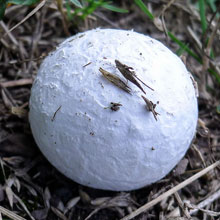
|
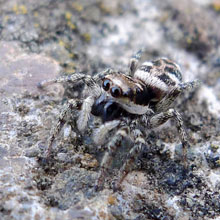
|
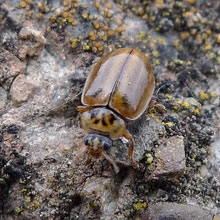
|
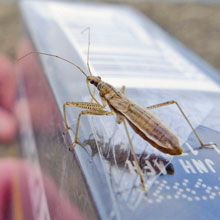
|
We found many
more birds when we
reached the Esk. There was a very large flock of Mute Swans at the
mouth of the river. A pair of adults with five large cygnets glided
past us. Then there was a bit of a commotion when a female Mallard flew
across the river chased by a Black-headed Gull. The duck had got hold
of a crab and wasn’t going to let it go. After a brief
struggle it flew
up the river leaving the gull trailing far behind. A minute later, a
Great Black-backed Gull flew over the calm scene. We wondered if it
would have intervened had it passed seconds earlier.
Mute Swan
|
Female Mallard
|
Black-headed Gull
|
Great Black-backed Gull
|
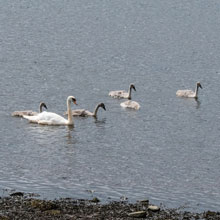
|
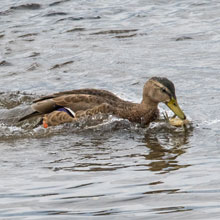
|
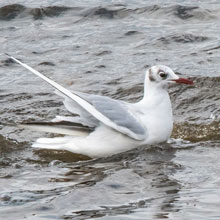
|
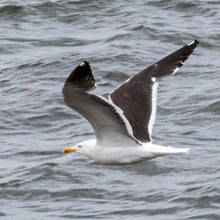
|
More of the
“usual suspects” were
to be seen going about their business on the riverside, Redshank,
Bar-tailed Godwits and Curlew. The sky had become overcast and the
light was low so we started on our return journey. The sea remained
disappointingly bereft of birds but microlight aircraft buzzed
westwards overhead giving me something to photograph.
Redshank
|
Curlew
|
Bar-tailed Godwit
|
Air Jockey
|
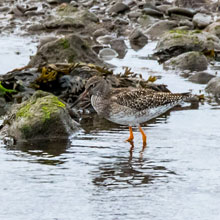
|
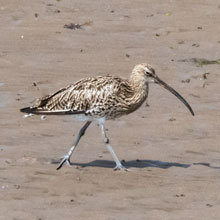
|
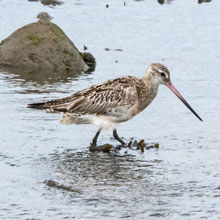
|
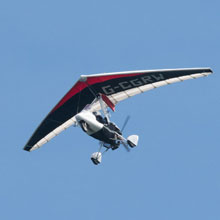
|
Just past the
east end of the
Scrapes I got a nice shot of a 2nd cycle Back-headed Gull on the shore
(see “Pictures of the Week” below. Close by, a 2nd
cycle Herring Gull
was finishing off a Razorshell. On a large seaweed-covered waste pipe
Eider and Cormorants were lounging in the gloomy conditions. Just as we
reached the car, a pair of Buzzards circled overhead but the poor light
meant my shots were little better than silhouettes.
2nd Cycle Herring Gull
|
Eider
|
Cormorant
|
Buzzard
|
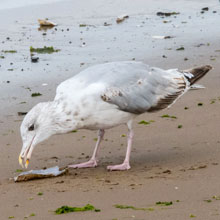
|
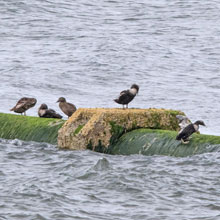
|
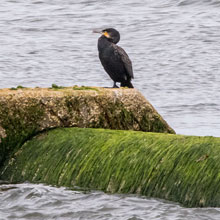
|
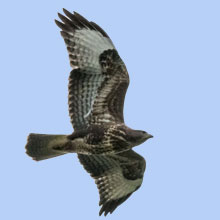
|
After the
longer-than-usual
circuit we were more than ready for our tea and buns with cinnamon
icing. Not a bad outing with some nice pictures taken and even a couple
of newbies, the Larch Ladybird and Damsel Bug. What a pity it ended on
a literally dull note as the Buzzard shots could have been great - oh
well, maybe next time!
Pictures of the
Week:
Sandwich Tern
|
Shelduck
|
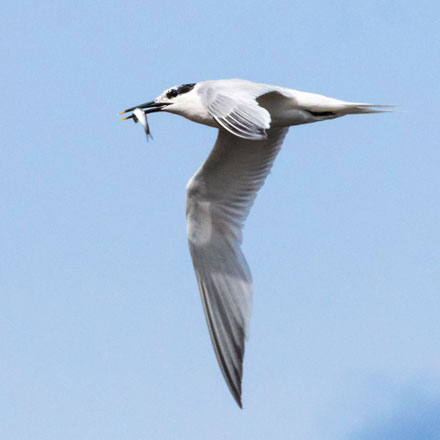
|
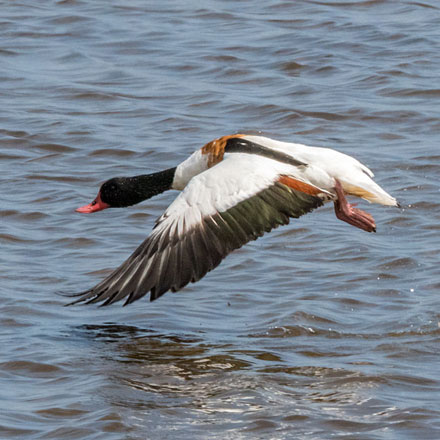
|
Speckled Wood
|
2nd Cycle Black-headed Gull
|
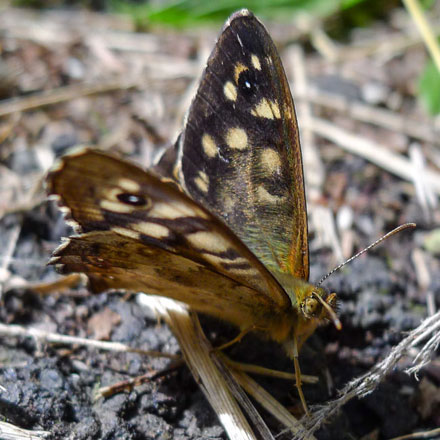
|
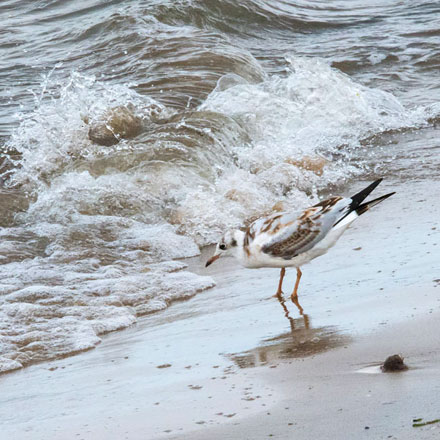
|
Back To Top
|

